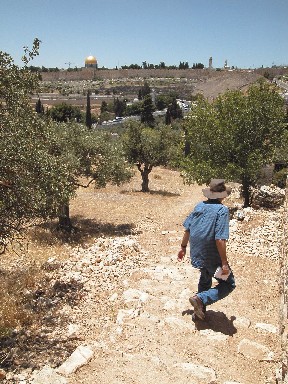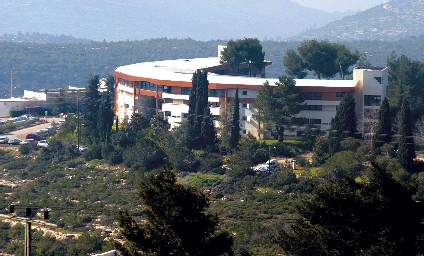|
ERETZ Magazine
|
Stayput Judean
Hills
The Judean Hills are covered
with the beautiful greenery of the Mediterranean and enchanting
little villages peek out from between the trees. Vineyards and
wineries abound, together with cheese makers and boutique farms.
The Judean Hills and the lowlands of the Shefelah have always
been a buffer zone between the sea peoples of the coastal plain and
the mountain peoples from the desert. Since the days of the Bible,
the Judean Hills have been a battle zone – Israelites from the hills
versus Philistines from the plains, Samson versus Delilah, David
versus Goliath, and Maccabees versus Greeks.
The Judean Hills have a unique environment. They are covered with
Mediterranean maquis, thick evergreen underbrush; the ancient
Hebrews learned to settle in these hills by clearing out forests and
cultivating the land. For thousands of years, the Judean Hills were
the hinterland that supplied Jerusalem with resources for its Temple
and food for its pilgrims.
Today the Judean Hills are still covered with the beautiful greenery
of the Mediterranean and enchanting little villages peek out from
between the trees. Vineyards and wineries abound, together with
cheese makers and a myriad of other boutique farms. Many of them
have visitors’ centers and restaurants that specialize in delicacies
made from local products. The area also abounds with springs, caves,
and hiking trails.
(Back to top)
The Mysterious Ein Zova
The spring of Ein Zova emanates from an underground cave that can
be reached through a tunnel. Hundreds of these systems were built in
the Judean Hills during the Roman period.
Kibbutz Zova is in the Jerusalem Mountains, not far from the Harel
Junction on Route 1, the Tel Aviv-Jerusalem highway. Enter the
kibbutz, cross it, and drive for about 800 meters along the old road
that once led to the kibbutz. Park in the small parking area near
the gate leading to the spring.
A 40-meter-long tunnel leads to the cave with the spring. The
kibbutz members have put lighting into the cave and tunnel and open
it to visitors for a small fee. The entrance to the tunnel is low,
but as you continue it gets higher, leading to a cave in which you
can stand up.
Near the parking lot there are two things to see – the Crusader
castle of Zova and a grand old oak tree, one of the oldest in the
country.
The site is open in the summer from 10 a.m. to 5 p.m.
(Back to top)
Ein Handak
Ein Handak, another of the tunnel-fed springs of the Judean
Mountains, is near the Hadassah Hospital in Jerusalem’s Ein Kerem
neighborhood. The area surrounding the spring hasn’t been developed,
making this a lovely natural site. Make sure to bring flashlights,
wading shoes, and bathing suits.
Drive from Hadassah Hospital along the road to Even Sapir. Continue
500 meters past the hospital parking lot and turn left. Follow the
road for 200 meters to a parking lot. A flight of steps leads down
into a large pool. The pool is 30 meters long and 3 meters deep,
with water flowing into the pool from two separate tunnels. The
tunnels are dark, so use flashlights when exploring them. The water
in the tunnels is about 1 meter deep. Be careful as you walk along
the longer branch of the tunnel – it has an underwater step. After
exploring the tunnels, walk down the ravine, heading away from the
parking lot, for 5 minutes, until you reach a 9.5-meter-high
terrace, built out of massive stones that looks like a miniature
version of the Western Wall. The terrace probably is from Roman
times. A terrace of this size constructed out of such huge stones
has yet to be found in any other place in Israel.
(Back to top)

Castel National Park
Castel National Park (Tel. (02) 533-0476) is located on the ruins
of a Crusader castle and an Arab village.
In the War of Independence, the site was an important army post,
which overlooked the main road to Jerusalem, and bloody battles were
fought for control of the Castel. Reconstructed bunkers and trenches
can be seen at the site, complete with explanatory signs. From the
top of the park, there is a breathtaking view of the Judean Hills.
(Back to top)
Motza
Visitors to Motza, just outside of Jerusalem, can view the old
synagogue and remains of the early houses of the colony, which was
founded in the late 1800s. The synagogue is in a Crusader building,
constructed on the remains of a Byzantine building. A guided tour of
the site tells the story of the colony.
(Back to top)
Mini-Israel
Mini-Israel is a unique showcase for the sites of Israel, built
of hundreds of models, most on a scale of 1:25. Caesarea, for
example, is depicted complete with its theater, port, fortress,
hippodrome, and aqueduct. Less-known sites such as the Weizmann
House, the Haifa German Colony, and Sergei House in Jerusalem, are
included as well. Mini Israel is the largest miniature park in the
world.
(Back to top)
Itinerary
Day 1: The Judean Hills
Drive to Shaar Hagai and follow Route 38 past Beit Shemesh to the
Beit Guvrin caves. Visit the caves and then return to Beit Shemesh
and continue to Shimshon Junction. Turn left onto Route 44 and take
it to Nahshon Junction. Turn left onto Route 3 and follow the signs
to Mini Israel for a visit.
(Back to top)
Day 2: Old City
Enter the Old City via the Jaffa Gate and visit the Tower of
David Museum, whose main exhibit focuses on the history of
Jerusalem. Then walk down David Street, the main souvenir market, to
the first intersection. Turn left onto Christian Quarter Street and
walk to the alley of Saint Helena that leads down to the Holy
Sepulcher. Exit by the small entrance to the courtyard that leads to
the Muristan Market. Walk straight ahead until you reach the busy
market street of Khan e-Zeit. Turn right and walk down the Crusader
markets. Turn left on David Street and go round the corner to
Sisileh Street. Walk down to the Kotel. Visit the Kotel, take the
Rabbi Yehudah Halevi steps up to the Jewish Quarter. Walk to Zion
Gate, outside the gate turn right, and walk back to the Jaffa Gate.
(Back to top)
Day 3: National Jerusalem
Start the tour with a visit to the Israel Museum. Then walk up to
the Knesset (tours on Sundays and Thursdays, reservations required)
and through the Rose Garden to the Supreme Court Building. Opposite
it is the Foreign Ministry and behind it the Bank of Israel. The
Prime Minister’s Office, Finance Ministry, and Interior Ministry are
lined up to your left. Drive to Yad Vashem (reservations
recommended) and then to Mount Herzl for a visit to the Herzl Museum
(reservations recommended). To end the tour, drive north on the
Begin Highway to the road leading up to Mount Scopus. Drive to the
eastern end of Mount Scopus for a view of the city.
(Back to top)
Day 4: Old Neighborhoods
Start tour at the Jaffa Street entrance of the Mahane Yehuda
Market. Walk through the market, cross Agripas and enter the Ohel
Moshe neighborhood. Walk down to Shilo Street and turn into
Beersheba Street to view the Adas Synagogue. Cross Bezalel, walk
down Even Sapir and Hirschenberg to the Sharei Hesed neighborhood.
Make your way to Kahanov Street to the Synagogue of the Birkat
Halevana. Make your way to Keren Kaymet Street. Turn left on Keren
Kaymet and right on Ussishkin Street. Turn left on Alharizi and walk
through the heart of Rehavia. Turn left on Ibn Gabirol Street and
right Keren Kaymet to reach the buildings of the Jewish Agency.
(Back to top)
Day 5: Tel Aviv
Drive to Tel Aviv. Exit Route 1 at Kibbutz Galuyot Street and
drive to Jaffa. Continue on Shlomo Street to Marzuk Veazar. Continue
straight to Razif Ha’aliyah Hasheniya Street. Walk up the slope to
Kikar Kedumim and to Gan Hapisga to view Tel Aviv. Cross Hazorfim
Street and Yefet Street to reach the flea market. Exit to the clock
tower square and cross Yefet again to Mifratz Shlomo. At the fork,
go right via Ruslan Street to return to your car. Head north to
Rothschild Boulevard to visit Independence Hall and to Ben-Gurion
Boulevard to visit Ben-Gurion House. End your visit with dinner at
one of the restaurants in the Tel Aviv Port.
(Back to top)
Day 6: A Day in the North
Take Route 1 to Route 6. Drive north on 6 until the end. Go east
on Route 65 to Megiddo Junction. Turn north onto 66 and visit
ancient Megiddo. Continue on 66 to Hatishbi Junction. Turn right at
the traffic light and drive to Hashomerim Junction. Turn right on
Route 75 and left onto Route 77. Take Route 65 to Route 85. Go right
on 85 and left on 90. Take Route 89 to Safed. Tour the old city.
Take Route 89 east to Route 866. Drive past Meron to Route 85 to
Acre. Tour the Old City of Acre. Take Route 4 to Haifa and continue
along the beach on Route 2 to Tel Aviv. Follow 2 to 20 and to Route
1, back to the Judean Hills.
(Back to top)
Neve Ilan
The hotel at Neve Ilan, operated by the C Hotels group, is
strategically located in the heart of the Judean Hills. During the
War of Independence, the main command post responsible for keeping
the road to Jerusalem open was located in this area. Today this area
is only minutes from Jerusalem on the main highway, though it
remains charmingly rustic and is full of wineries and kibbutzim.The
hotel at Neve Ilan is an ideal base for exploring this area as well
as Jerusalem and the coastal plain. It has 160 large, spacious
guestrooms, including four with private jacuzzis. Most of the
guestrooms can accommodate up to four people. In addition, the hotel
has a sports club with an outdoor pool that is heated and covered in
winter, a fitness room, a sauna and a jacuzzi, expansive lawns, a
balcony that offers a beautiful view of the surrounding mountains, a
gift shop, and facilities for conference and special events. The
hotel is only a short drive from the Beit Guvrin National Park,
Latrun, Mini-Israel, and the village of Abu Ghosh, which is known
for its excellent restaurants.

(Back to top)
|
|